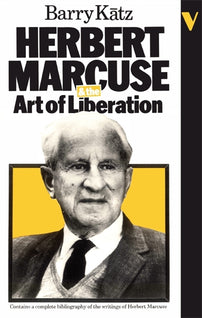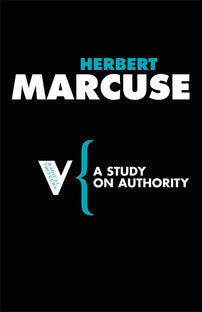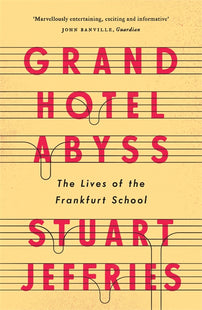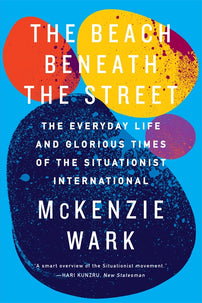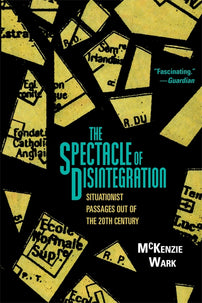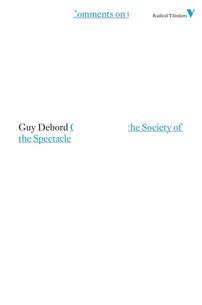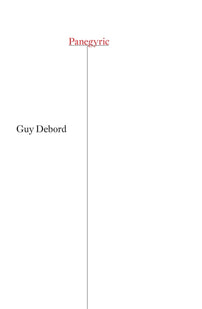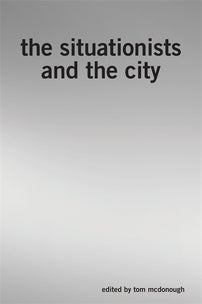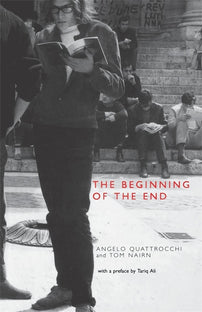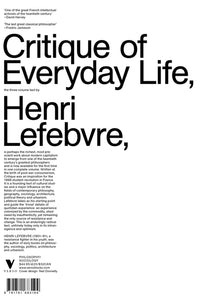Lettrism and the Youth Uprising of 68
A translation of Isidore Isou’s "Between Isou and Marcuse," published in the Lettrist journal Youth Uprising in the summer of 1968.
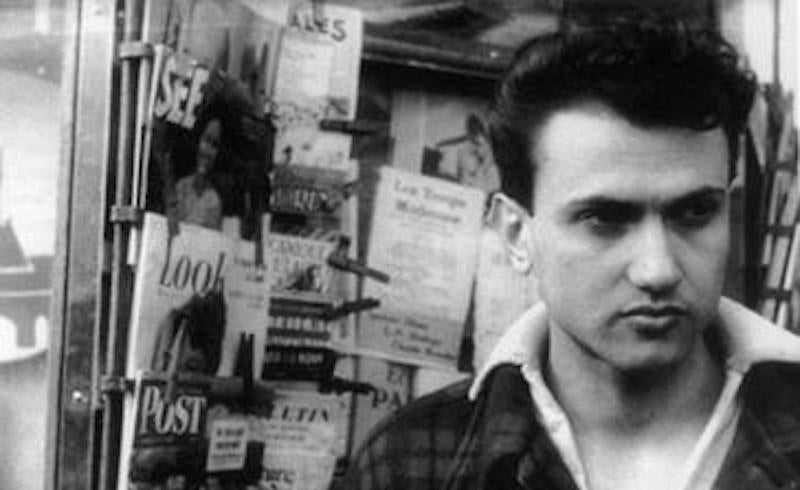
Translated and introduced by Joel White.

As Kristin Ross has made explicit, the variety of writers who are supposedly the true theoretical progenitors of France’s May 68 has not stopped proliferating since the “events” came to a close. Herbert Marcuse’s Eros and Civilisation, Wilhelm Reich’s The Mass Psychology of Fascism, and Henri Lefebvre’s Critique of Everyday Life come to mind. Whole books have been dedicated to defining what is now known as la pensée 68 (the thought of 68). Perhaps the most notorious of these so-called progenitors is Situationist Guy Debord, who, late into his life, even megalomaniacally claimed that it was he who "chose the time and direction of the attacks" (Guy Debord, Anselm Jappe, 100).
Before Debord and the Situationist International, however, there was Isidore Isou and Lettrism. Creator or novateur of the French avant-garde group, Isou moved to Paris in 1945 with the single purpose of founding a movement that would surpass Tristan Tzara’s Dadaism and André Breton’s Surrealism. Regarding these movements as exhausted of revolutionary and creative potential, Isou and his early supporters, Maurice Lemaître, Gil J. Wolman, and Guy Debord set out to reinvigorate France’s artistic and political avant-garde. (Wolman and Debord would later split to form the Lettrist International in 1952 before finally creating the Situationist International in 1957). Artistically, this meant "creatively diverting" (créativité détourné) the material support of formal artworks so that new possibilities latent in the material could become manifest. Words were reduced to graphemes and phonemes and then built back up again to make "hypergraphic" or "lettrie" poems. Images and figures were morphed into shadowy blocks that would consume themselves, and films were "chiselled" and scratched to which "discrepant sounds" were added and juxtaposed (for example, Lemâitre’s 1969 film Youth Uprising – May 68). While this had significant influence, via the Situationist International, on the aesthetics of 68, it is Isou’s "nuclear" political economy and his manifestos for the Youth Uprising (1949) that hold the most weight. The notion of the abolishment of "youth-capital" found in Debord’s Society of the Spectacle (1967) and Mustapha Khayat’s On the Poverty of Student Life (1966) both develop the notion of a youth "externalised" from capital’s internal exchange "circuits." For Isou, the youth constituted the "primary revolutionary force" of any insurrection because of their not-yet internalised but likewise exploited, socio-economic status. Isou even complains in 1974 that his particular conception of the revolutionary youth was the "real motor of the youth uprising in May 68," and not the "neo-Nazi situationists" that only knew how to plagiarise him.
Translated here for the first time is a rare text published in the summer of 1968: no.5 of the second series of the Lettrist journal Youth Uprising, entitled "Between Isou and Marcuse." In true Lettrist style, Isou (who writes in the third person) both insults and lampoons Marcuse’s "sub-sub-Marxism," while excessively praising his own philosophical and political rigour. Correct or not in its assessment of Marcuse’s and Isou’s influence on ‘68, this text should be read as one of the first and most explicit attempts at theoretically re-appropriating May. Much of this text is also included into the script for Lemâitre’s 1969 film Youth Uprising – May 68 (this film can be found on display in room 33 at the Pompidou Centre, Paris). While the direct causal relationship between intellectual or theoretical development and political practice must always be subject to suspicion, the often oblique and implicit influence that texts and thoughts have on action must not be overlooked. After all, cannot dialectics break bricks?
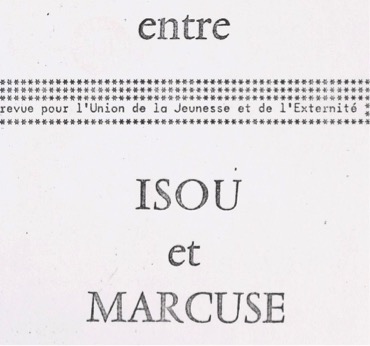
Youth Uprising
(Number five)
"Between Isou and Marcuse"
(Summer 68)
*
The differences between the rigorous and reflective system of "Nuclear Economics" and the ersatz sociologist sub-sub-Freudist and sub-sub-Marxist Herbert Marcuse
*
There is no just revolutionary action without just revolutionary theory. We must, therefore, clarify the ideological and practical bases of the youth uprising.
Isou published the book Youth Uprising in 1949. Herbert Marcuse, who worked for the American O.S.S until 1945 [The Office of Strategic Services, which is a precursor to the CIA], published his first book against "industrial society," Eros and Civilization, in 1955, six years after the work of Isidore Isou, and One-Dimensional Man in 1964, 15 years after the work of Isidore Isou.
If any connection is to be established between Isou's revolutionary theory and Marcuse’s, the latter should be considered as a plagiarist of Isou. For any authentically creative [créateur] and revolutionary movement cannot have as its doctrine the work of a plagiarist.
Isidore Isou is an economist and his works, which deal with the uprising of the youth, are works of political economy; while Herbert Marcuse is a fragmentary and fraudulent sociologist, and his books are works of sociology.
A) Isou's principle work of political economy (Treaty on Nuclear Economy, Volume 1: Youth Uprising) departs from the acquired economic knowledge of Adam Smith, Keynes, and Karl Marx, and describes the exchange circuit of producers. It studies the components of this exchange circuit, namely the amounts of prescribed pain/pleasure that are dosed out. It also makes the discovery that outside of this circuit exists a zone of reality more immense than the internal circuit, constituted, for the most part, by millions of young people, or externals.
*
It analyses the components of this zone, namely the amount of free labour that results from the juventiste situation, and how this establishes and explains the slavery and over-exploitation of the youth. It also demonstrates how this amount of work, otherwise employed, would have the time to express itself culturally in art, philosophy, science, and applied techniques (including economic and social structures). A cultural expression that for Isou constitutes pure creativity [créativité pure], multiplying the powers of human enrichment. Or, alternatively, how this amount of exploited labour could outburst into massacre, war or revolution, what Isou calls diverted creativity [créativité détournée], multiplying the powers of destruction. Both sets are quantitative elements that have been formulated mathematically.
By reorganising the entire economic sphere as revealed by Isou, we find that the categories of the old circuit are only residues that are poorly defined by economic theory passed down from Adam Smith to Keynes via Marx. Thus, the author of Youth Uprising has established nuclear economics, which radically alters, expands upon and offers a new and complete explanation of the characteristics of the internal layers of the population, for example, workers, artisans, small traders and more substantial business owners etc. All the notions of trade (such as goods supplied and demanded, prices, fiduciary values, structures of education, credit, planning) have been drastically transformed by this new economic doctrine that bases its findings on quantified elements backed up by as-yet unpublished formulated equations.
*
This juventiste nuclear theory will take over and replace the atomistic (liberal) and the molecular economic theories ("critical," Marxist, collectivist), just how in other domains, the physical elements have been radically altered, expanded and redefined by nuclear physics.
B) Like all sociologists who start from a crude and superficial vision of a society that is "in-itself," Herbert Marcuse proposes an idealistic, artificial, "petty-bourgeois" image of the human world that is devoid of actual elements or stages of progressive development. He proposes an image of a “Moloch Being” that can only be confronted by Nothingness or by blindly destroying it like totalitarians. In other words, with a foolish rage that mirrors neo-fascist or neo-Nazi massacres. A form of destruction after which there will only remain unusable ruins, a universe of the dead or only two or more enemy camps. It implies the "artistic" suicide of society's promoters. All this death in the name of emancipating only a certain number of industrial groups and the so-called liberating attack on "consumer societies" and erotic oppression.
According to the author of One-Dimensional Man, what he called in 1960 "organizational capitalism," and what later is expanded to embrace State socialism and Stalinism, in short, ANY TECHNICAL INDUSTRIAL ORGANIZATION, necessarily transforms itself into a self-regulating and overriding despotic system by perfecting methods of mystification, by manipulating individuals, and by pacifying existence through stupefying opulence. (Freudianism itself was intended to heal the Individual so that the Individual could continue to function as part of an ailing civilisation, because therapy, a school of resignation, "transforms," even according to Freud himself, “hysterical misery into ordinary misfortune")
*
The cliques of repressive and oppressive leaders of "liberal" and "communist" nations perpetuate the tyrannical conditioning of consciences through the moronic education of an omnipresent ideology and prohibit the possibility of any criticism of, any escape from, or refusal of what they consider to be human finality. This ideology is present at the University, in mass consumption, and in the superficial satisfaction that allows totalitarian monopolies to amass immense profits and to indoctrinate [embrigadant] and predetermine the capabilities and gratifications of mutilated masses and their psychisms. These psychisms have been linked to a false "system of needs:" the refrigerator and the car becoming symbols of this enslavement. Marcuse finds a solution to this order only in a revolution of those "left-behind" [aissés-pour-compte] (the unemployed, the delinquents, the racial minorities or the intellectuals). But since he ignores Isouian economic differences (mathematically formulated and quantified differences between externals and internals, and among the externals, between creators and producers), he does not see that those de-classed [déclassés] by the social system are, as much as they are those who have been discarded and rejected by the internality [êtres déchus et rejetés par l'internité] (and from which they have acquired their particular habits) they are also conditioned by the system of internal values and, therefore, aspire to obtain desired goods. Some "black" groups destroy white shops to steal refrigerators, radios and television sets, and workers of the internal "radical reformist classes," [classes revendicatives] are attracted to luxury clothing brands. 1
*
Herbert Marcuse, with his superficial sociological system of total oppression, justifies all the "machine destroyers" of the last century — which Lenin called troglodytes — who, during the great period of the Russian Revolution, wanted to annihilate all the instruments of progress brought about by the previous regimes (for them even the railways were the fruit of capitalism). He justifies "populists" such as Tolstoy and Gandhi, as much as the older generation of anarchists (such as Bakunin, still a disciple of Nechaev, the Bonnot gang, and Vaillant): those who wanted "to fuck the whole of society up." 2 This is a method that was equally taken up by fascists who became admirers of Georges Sorel's "myth of violence"; and by Nazis, for whom the entire capitalist and communist society (Judeo-capitalist-communist) was rotten — "rotten to the core" — and who hence necessitated the arrival of a pure people (otherwise known as Aryans) to create a new social world order. All these elements are not analysed by Marcuse or his followers.
Unfortunately, these random acts of destruction frighten people and communities — people and communities being the organised forms for which life is preferable to death. 3 And consequently scared people seek en masse the protection of the “generals of order," even the barracks, which explains the military regimes of Spain (where the so-called anarchists were so active), Greece, Algeria, Indonesia, USA, also France, and many black African countries, not to mention neo-Stalinist dictatorships such as the USSR, and Poland soon, etc. etc.
*
We consider that the militant youth movements of today have been subject to three dominant influences, which we believe can be ordered and confirmed according to their cultural and scientific accuracy; all of which have differing importance for man's evolution towards a society of abundance, permanent creative power, and joy:
1) The Influence of Herbert Marcuse
The sub-sub-Freudist sociologist and sub-sub-Marxist, whose abstract and superficial vision reduces the liberating forces of Freudianism and the revolutionary liberating powers of Marxism (powers rightly considered by our author as fragmentary, falsified, and insufficient, but which remain, nevertheless, authentic powers) to the workings of a totalitarian and oppressive society. This reduction, instead of breaking it down [non-décomposée] into either its creative or progressive elements or its static or reactionary elements. For him, an oppressive society can only be destroyed in a non-analytic and non-strategic manner by crises of blind revolt. These incoherent eruptions partake in a history of blind anarchist revolt that goes from Bakunin to Bonnot (it is also important not to forget the progressive and pacifist part played by a history of anarchist thinkers that goes from Proudhon, from Bakunin himself, and from Kropotkin to today's anarchists). This blind anarchism causes death and anguish in any society, leading mathematically and regrettably to reactive forces taking control using military intervention or by a barracks-logic [I'ordre des casernes]. (For example, Franco's colonels and the military junta of Greece to the communist dictators and assassins of anarchists, from Trotsky and Stalin to Mao Tse-tung). By appealing to unscientific rebels, MARCUSE IS THE THEORETICIAN OF THE CURRENT OPPRESSIVE REGIMES, SENSELESS REVOLTS, AND JUSTIFIES THE ARRIVAL OF THE NEXT OPPRESSIVE REGIME.
*
2) The Influence of Marxism
The author of Capital develops an understanding of the economy as composed of doses of pain and pleasure, a theory of the "division of labour" inherited from Adam Smith, J. B. Say, and Ricardo. He observes, like Sismondi and Proudhon, that an unequal relation to ownership and production results in a process whereby surplus-value and the distribution of profit are unequally circulated to certain "classes.” Hence the concept of "class struggle," a struggle which will necessarily lead to the victory of the proletariat (the most exploited [malheureuse] category) and a classless society.
a) Unfortunately, the proletariat is only the "poor" part of the circuit (the latter being only a small residual sector of the general economic sphere). The "rich" part consists of the landowner, the capitalist, and the wealthy bourgeoisie. The workers' mass can be "radically reformist" [revendicative] and can even, when helped by "the externality," seize the whole of society. Nonetheless, the working class intrinsically has no creative or progressive virtue, and its dictatorship — which necessarily leads to Stalinist archetypes — is a dogmatic, cretinising, and totalitarian matrix.
b) The proletarian economic structure, which transforms itself into the basis of Culture, (4) becomes the straitjacket of a degenerate Knowledge. For example, in art, there is the multiplication of Zhdanovism or pompier painting, literature, and cinema etc. In philosophy, all yet-to-be-published developments are prohibited. Freudianism and its psychological contributions are banished. The phenomenological description (whether Husserlian, existentialist, or Heideggerian, etc.) is excluded. There is also the prohibition of any scientific innovation, the condemnation of Einstein in physics, of Mendel and Morgan in biology, alongside chauvinistic praise for Lysenko's mistakes, etc.
*
Compared to Herbert Marcuse's artificial theories that are based on a sociological vision of a global totalitarian world (and of the blind revolts against it), the Marxist class theory offers a partial image of reality and its conflicts. It is incorrect, however, to consider it as the system of economic totality, as it either leads to cretinising dictatorships, an inverted sclerotic society, or a "liberalist" and chaotic Culture of “progress.”
3) The Isouian Influence
Finally, the Isouian conception offers us the complete description of an integrated economic sphere. The static circuit of internals and their mathematically quantified apportions [doses] of pain/pleasure situate themselves within a circuit that represents about half of the entire economic sphere. A layer of externality is located around this internality and is composed of quantitative and mathematically determined apportions [doses] of unpaid labour, such as the youth. The externals, who regularly interrupt this circuit — especially when they manage to excite other "classes" to internal conflict — contain powers of pure creativity (innovative, cultural) and of periodically diverted creativity [créativité détournée] (wars, revolutions). Both forms of creativity constitute successively liberating powers (already historically experienced) when society ceases to appear like Marcuse's artificial, oppressive and hopeless world. If diverted creativity, or revolutions of the youth, (alongside the strategic unfolding of an alliance between university and high school students, outsourced workers and disbanded soldiers) become more and more frequent, then PURE CREATIVITY and its divisions into branches (kladosics), such as the arts, philosophy, science, and applied and empirical technology, will come to possess the golden paths of novation and exploration, representing authentic Progress. This Progress will finally lead to both the unveiling of an integrated map of humanity and its environment and to the constitution of a paradisic [paradisique] world, where people will live in everlasting creative joy.
*
Conclusion
The sociological system of Herbert Marcuse, proposing a purely abstract, artificial image of a stupefying, self-regulating civilisation from which one can escape only through indiscriminate revolts, offers a justification to the most reactionary and inglorious of regimes, to the Hitlerian and Francoist barracks. In this sense, this "idealist", "petit-bourgeois" system is easily identified as the "terrorist" pretext and accomplice to a fascist or Nazi dictatorship.
The Isouian nuclear economic system, conversely, has remained the promoter, from as early as 1949, of progressive liberation strikes performed by the youth — by millions of externals and young people. Thanks to Culture and to its novative [novatrices] golden paths such as art, philosophy, science, and applied technology, which will be empowered by the kladosic strategy and a revolution of the youth, this system will tend toward the ultimate defeat of all diverted creativity and massacres that have existed from the origins of humanity to Hitler. (Youth in the growing sense: students, high school students, outsourced workers, outsourced and reconverted soldiers). Ious’s system, therefore, proves to be, on final analysis, THE ONLY CONCEPTION HAVING AS AN EVALUATED AND CONCRETE OBJECTIVE: THE STRUCTURES OF SCHOOL, CREDIT, PLANNING, AND THE CYCLICAL MANAGEMENT OF NOVATORS [LA DIRECTION ROTATIVE NOVATEURS], that is, the basis for a better society.
*
It is necessary to oppose the antinomy: "society of consumption" – "society of famine”, with the antinomies: "internal-external" and "creator-ersatz falsifier" (or just producer). 5
The theories of Herbert Marcuse must join the sociological ash heap of history alongside Lévy-Bruhl and Moritz Rosenberg, the different totalitarianisms (idealist or "petit-bourgeois"), the Zhdanovisms, the jarrivismes, the globalists [les englobants], the situationisms (sic); movements that have been progressively swept away by Lettrism and the theory of nuclear economics, whose contributions, continuously being verified and justified with complete accuracy in many fields of knowledge, gain new territory in the works of every country in the world.
Notes
1. "It is only for the sake of those without hope, that hope is given to us" concludes Marcuse in One-Dimensional Man, citing this phrase from writer Walter Benjamin. However, regarding quantities of goods and services and free, unpaid labour (that is, according to the system of nuclear economics) everyone has hope and at the same time proves to be hopeless. Only the hierarchy between doses of paid goods and services and doses of free unpaid labour (labour which searches, at the same time, for situations where it can be paid), only creative content capable of giving new goods and new hope (in short, the distinction between external and internal and between internal innovators and internal producers with respect to specific markets, and which can be broken down into thematic degrees of possession and possession-expectations, on the one hand, and dispossession and despair-of-possession, on the other hand), only these distinctions, let us say, can explain human conflict and the successful and paradisic outcomes of these conflicts.
2. "The present generation must blindly destroy all that exists without distinction, and with this single thought: as much as possible and as quickly as possible," by using "poison, daggers, rope, etc. The Revolution sanctifies everything in this area; the field is free." (cf. Michail Bakunin's Sozialpolitik Briefwechsel translated into French by Perrin & Co. in 1902). The result was that the Czar, Alexander II, who had emancipated the serfs, then returned to his father's, Nicholas II, cruel system of repression. Bakunin later condemned this text (wrongly attributed to him) and claimed to have made a mistake in accepting it.
3. In this sense, Georg Lukacs is right when he writes about the Frankfurt-am-Main "pessimists," Adorno and Marcuse: "You took rooms at the Grand Hotel de l'Abîme. The food, there, is refined, the service impeccable, the rooms comfortable… You hold it (the abyss) in place with fear, and it gives the food and the comfort of the hotel a certain taste ".
4. Having become, according to Marx, a simple superstructure and often a mere reflection of the relations of production, whereas, and conversely, it is the artistic, philosophical, scientific and everyday culture that leads to technical applications and the division of work and class.
5. Creators, coming from the zone of externality, enter all levels and branches of internal society. Unfortunately, however, they only partially arrive; for instance, the culture that reads en masse Sade and Lautréamont and that welcomes the "bikini" and other sexual and material freedoms, is no longer the society which once read en masse Déroulède, and where ragged workers worked fourteen hours a day. Society does not integrate opposing forces, as Marcuse asserts: it cracks, explodes and evolves with all its theoretical and practical components thanks to the novateurs. Unfortunately, these creations were only partial, and the sclerotic dialectics of "ersatz" thinkers have allowed in fraudulent acquisitions of progress. However, against this set of blind, totalitarian and neo-Nazi critics, creativity continues to enter all cultural and social domains, finally permitting the transformation of being and its milieu to take place.
[book-strip index="1" style="display"]
